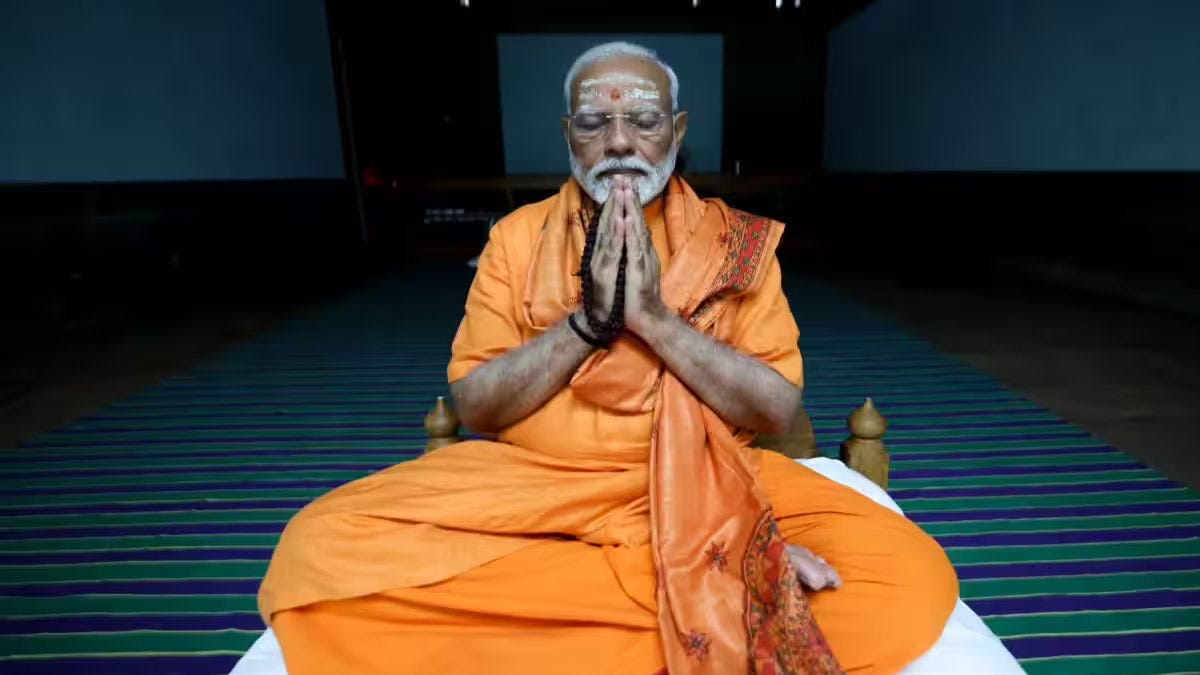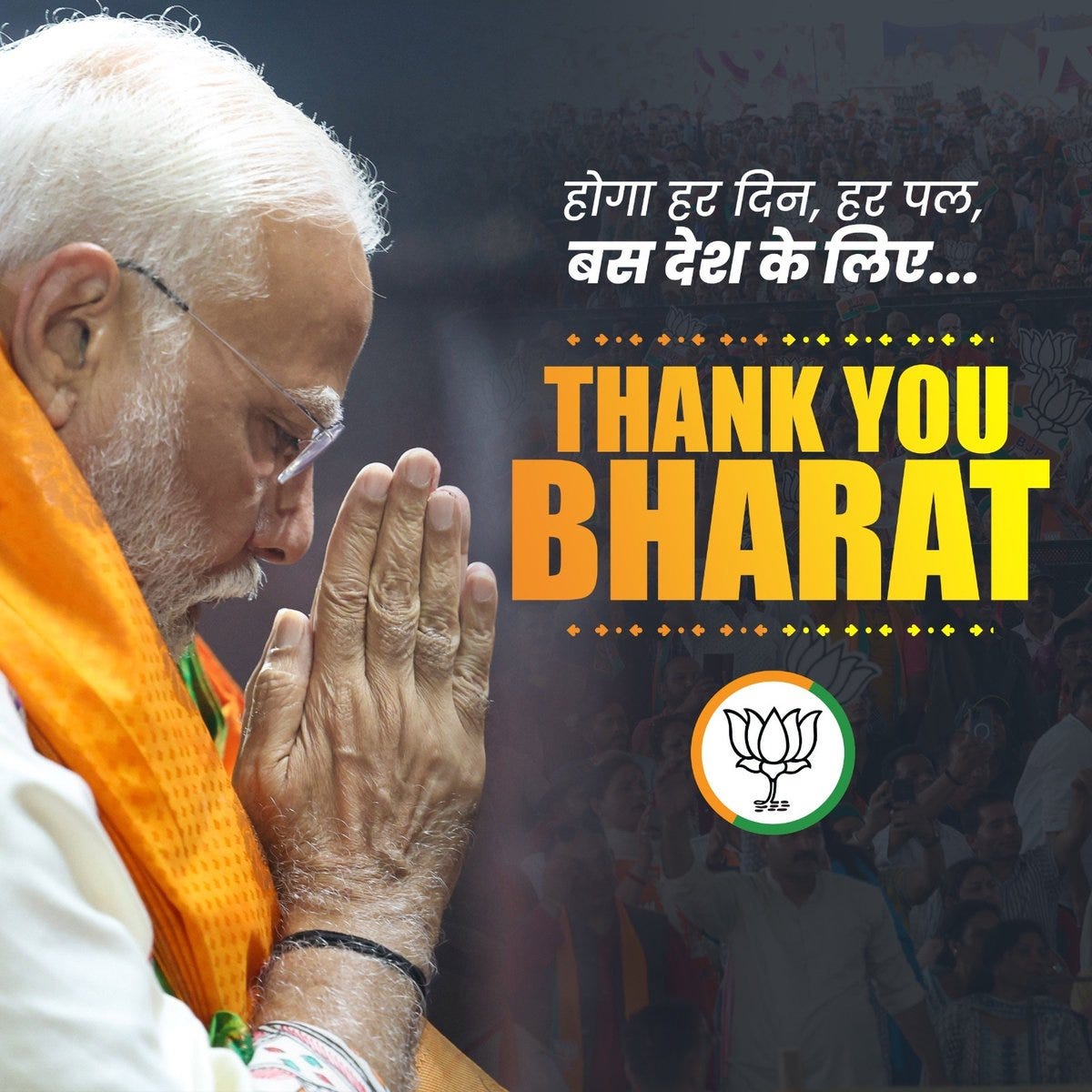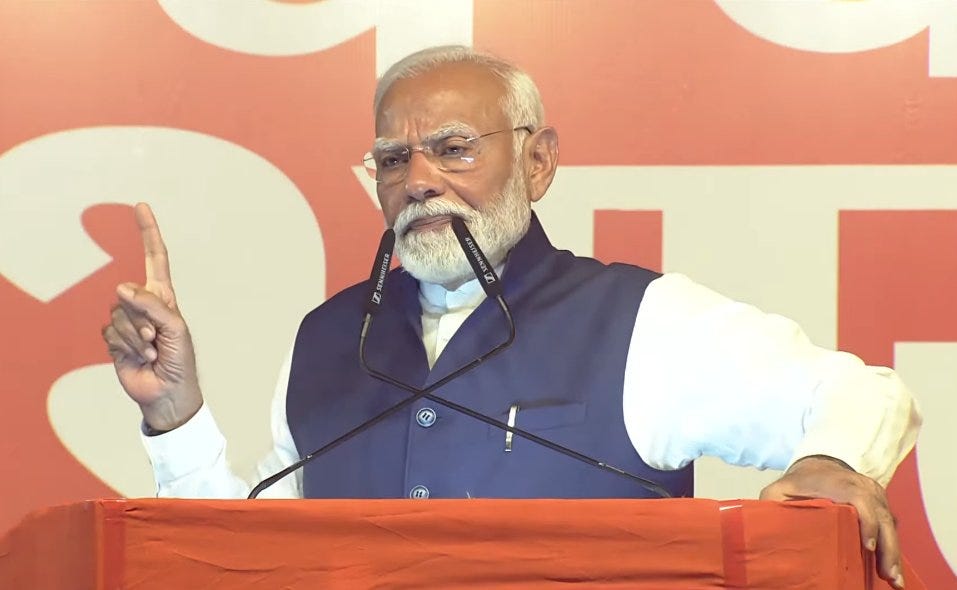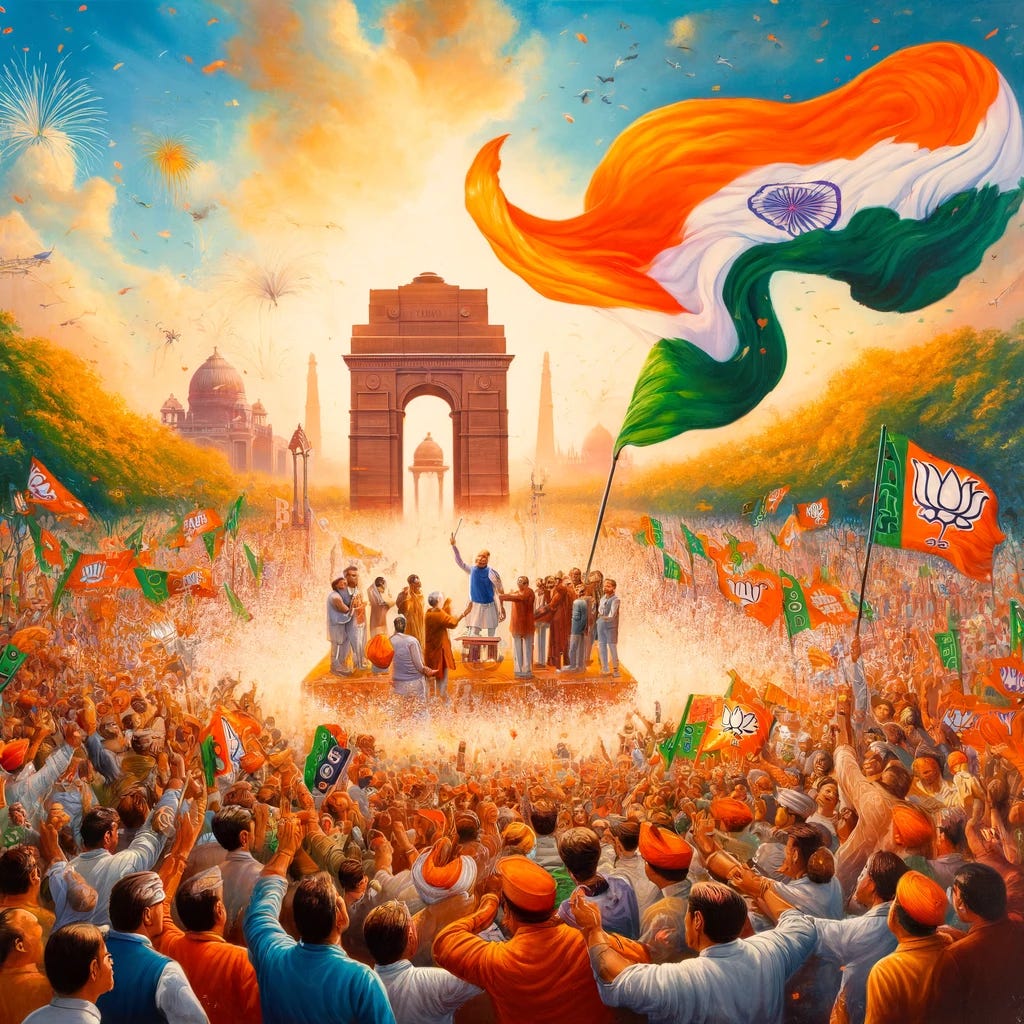Modi 3.0 Government: NDA Trudging towards a Slow Victory
15 Emerging Contours on the Horizon: The Monk who soldiered alone and soldered the entire nation into One Country— "Akhand Bharat"
Modi trudging to a slow victory
The Lok Sabha election results are steadily pouring in, and Prime Minister Narendra Modi’s anticipated cruise to an easy victory appears to be hitting major speed-breakers. The Bharatiya Janata Party (BJP) is likely to fall well short of an absolute majority on its own, with a projected tally of around 240 against the magic mid-way figure of 272. BJP may, therefore, have to rely on two of its allies—the Janata Dal (United) and the Telugu Desam Party—who are leading in close to 30 seats when taken together. However, they joined the NDA just months before the elections, and their party supremos have yet to issue categorical statements, sending a surge of anxiety, if not nervousness, among the top BJP strategists. They have, however, told Reuters that they will stand by the party.
Important decisions shall be now constitutionally difficult to make
The BJP has, no doubt, breached a few citadels that once seemed impregnable, but the mandate can at best be described as muted, if not half-hearted, and is nowhere close to the "400 पार" (400 paar). While the BJP, with its allies, may be able to form a coalition government, its elbow room in policy matters and executive decisions will be far more limited. Constitutional amendments, which require a two-thirds majority in both houses of Parliament, will be virtually impossible without conscious consent of the opposition. Historically, JD(U) and TDP have not been the most reliable allies and are sure to keep the coalition leaders on their toes, demanding and extracting their pound of flesh in important matters, such as the election of the Lok Sabha Speaker—a constitutional post that decides the disqualification of Lok Sabha MPs under the anti-defection laws.
Uttar Pradesh disappoints
The most disappointing development would be the poor performance in Uttar Pradesh, India’s largest state in terms of population, area, and number of Lok Sabha seats (80). However, the most heart-breaking result would be losing in Ayodhya (Faizabad) so soon after the Ram Mandir consecration, which was described as an event of the millennium. Political observers are already alluding to the subterranean stresses between PM Modi’s supporters and those of UP CM Yogi Adityanath at the grassroots level.
Unfolding scenario
Opposition leaders and Modi-baiters, who were hoping for a miracle despite near-unanimous exit poll projections, will no doubt be upbeat. Congress Party leader Rahul Gandhi, in his latest press conference, has claimed a moral victory.
Irrespective of how things unfold from here onward, it’s quite certain that the larger-than-life image of PM Narendra Modi has taken a serious dent since his campaign was centred on his string of rallies in this seven-phase election, during which he campaigned indefatigably for nearly three months. PM Modi addressed the party workers in Delhi a short while ago but here’s what he tweeted— his first public statement on the day of the couniting,
What lies ahead
In view of the emerging scenario, while other experts are generally trying to give reasons for this near-dramatic shift in the projected outcome—which, in our opinion, is more like a post-mortem examination—we aim to analyze the situation and present our take on the fifteen likely features of the Modi 3.0 administration:
1. Decreased Power for Modi within BJP, and amongst Allies
Prime Minister Modi will no doubt remain the most powerful leader within the BJP, but his image as a towering titan will be significantly diminished, especially among allies. The position of the chief strategist, Amit Shah, would also be slightly eroded, while Yogi Adityanath may begin to be seen as the Brutus who surreptitiously engineered the dismal results in Uttar Pradesh. Leaders like Rajnath Singh and Nitin Gadkari, who can engage ally partners and even opposition MPs better, may be back in focus. Having said that, there appears to be no immediate challenge to Narendra Modi’s overall leadership, either from within or outside his party.
2. Saving Grace in the Hindi Belt
Despite serious setbacks in the seats previously held in Uttar Pradesh and Rajasthan, Madhya Pradesh has continued to be a safe haven for the BJP. However, the BJP’s pre-eminent position as the frontrunner in the Hindi belt has been lost. The party's agenda to restore Hindu pride appeared to be resonating during the campaign, with the consecration of the Ram Mandir in Ayodhya being a significant milestone, but it appears that issues like inflation and unemployment swayed the voters more. The openly strident anti-Muslim campaign by the BJP seems to have alienated Muslims across the country, not merely in UP, prompting them to boycott the saffron party en masse. Be that as it may, suffice it to say that the Mandir, Mutton, and Muslim rhetoric has performed well below the expectations of PM Modi and his campaign managers.
3. Re-emergence of RSS in Political Sphere:
The Rashtriya Swayamsevak Sangh (RSS), led by Sarsanghchalak Mohan Bhagwat, might privately view this outcome as a positive development the context of its stated role as the independent representative of Indian, Arya, or Hindu culture. The BJP had already squeezed out the RSS from political space and decision-making in the party as well as in the government, and RSS watched quietly as some of its cultural and civilisational agenda were subsumed by the BJP, either directly as a political party or through governmental entities. The latest developments may lead to a regrouping and realignment of forces within the RSS and also in terms of its engagement with the BJP. Beyond the NDA alliance partners, the RSS would definitely re-emerge as a significant stakeholder in the decision-making process regarding the formation and running of the coalition government.
4. Clear Verdict from Delhi
The election results in Delhi indicate no sympathy wave for the incarcerated Arvind Kejriwal, despite his 21-day reprieve by the Supreme Court to campaign. Even with the Aam Aadmi Party (AAP) and Congress contesting together, the people of Delhi have given a clear mandate for Modi in the Lok Sabha. Does this diminish—according to Kejriwal’s own public statements—his chances of securing bail? Expedited trials on various fronts, such as the Delhi Liquor Excise case, the National Herald case, and the Swati Maliwal matter, were expected, but now the prosecution agencies may be a little less relentless in their crusade. The drinking water crisis and the ongoing legal difficulties for the AAP leadership have definitely destabilised the AAP government. However, while Kejriwal is not expected to resign, President's Rule in Delhi cannot be ruled out. But who knows, we may see an early election in Delhi.
5. Dismal in Punjab— draws blank
Despite failing to secure any of Punjab's 13 Lok Sabha seats, the BJP witnessed a significant increase in its vote share— all-time high for it— surpassing its former ally, the Shiromani Akali Dal (SAD). This suggests a significant consolidation of Hindu votes, particularly in urban areas, influenced by factors like the Ram Mandir initiative. However, this surge wasn't sufficient to translate into electoral victories. The unexpected defeat of BJP candidate Ravneet Bittu, grandson of former Punjab CM Beant Singh and a recent “recruit” from Congress, underscores the critical importance of securing rural votes, even in predominantly urban and Hindu constituencies with substantial migrant populations from Uttar Pradesh and Bihar. Contesting their first Lok Sabha election in decades without the SAD, the BJP made concerted efforts to court the Sikh community, evident in Prime Minister Modi's addresses at four public rallies in Punjab. While the complete whitewash may be a setback, the BJP's long-term strategy appears focused on cultivating goodwill among Punjab's populace, particularly the Sikhs who constitute the majority, potentially signaling a sustained effort to establish a strong foothold in this strategically significant border state.
6. Resurgence of BJP in Odisha and Muted Performance inWest Bengal
The state of Odisha witnessed a saffron surge as the BJP effectively ended the incumbent Chief Minister Naveen Patnaik's decades-long reign, paving the way for a BJP government in the state. Further solidifying this victory, the BJP secured a record number of Lok Sabha seats, achieving this feat on its own, without any alliances. This resounding win in Odisha significantly bolsters the BJP's claim to being a truly pan-Indian party, demonstrating its ability to resonate with voters and secure decisive mandates across diverse regions of the country.
The BJP's expected resurgence in West Bengal, however, did not materialise, though its performance is not unimpressive by any standards. However, this does not imply that the troubles for the Trinamool Congress (TMC) and its supremo Mamata Banerjee are over. The policy of reservations for Muslims in the state by the TMC government, under the guise of OBC reservation, which was set aside by the Calcutta High Court, appears to have polarised the Hindu community somewhat in favour of the BJP, but swung the Muslim voters en masse towards the TMC. The Central Government may now increase direct investigative and penal action through agencies like the Enforcement Directorate (ED) and the Central Bureau of Investigation (CBI), intensifying pressure on Banerjee and her party. Members of the All-India Services, who might have been manifestly partisan, could be in trouble. However, the thrust would definitely be milder now.
7. Significant Gains in Tamil Nadu and Kerala:
While the BJP secured only one seat from Kerala, while drawing blank in Tamil Nadu, their increased vote share, particularly as a standalone contender, signifies a notable development. The party's breakthrough victory in Kerala, wresting the Thrissur seat, marks a significant moment. Although Shashi Tharoor retained his seat in Thiruvananthapuram, the BJP's overall performance, especially the emergence of young leaders like K. Annamalai in Tamil Nadu, suggests a growing acceptance of the party in these traditionally challenging southern states. This progress, even without sweeping victories, indicates a potential shift in the political landscape. Under Prime Minister Modi's leadership, the BJP is expected to continue its focused efforts in these states, potentially keeping the incumbent governments on their toes and impacting future electoral contests.
8. Case of Jammu and Kashmir
The recent Jammu and Kashmir elections stand as a significant testament to democratic processes, marked by the highest voter turnout in the region's history. Conducted after the abrogation of Article 370, these elections held particular weight. While the BJP didn't anticipate securing seats within the Kashmir Valley, their stronghold in the Udhampur constituency remained firm, with Dr. Jitendra Singh, a junior minister in Prime Minister Modi's cabinet, securing a comfortable victory. The focus now shifts towards the Jammu and Kashmir Legislative Assembly elections, as indicated by the Chief Election Commissioner (CEC). These elections are perceived as a crucial step towards the full integration of Jammu and Kashmir as a state within the Union of India. The defeat of prominent regional figures like Omar Abdullah and Mehbooba Mufti signifies a potential shift in the political landscape. This outcome suggests a growing disillusionment among the populace with established political parties that have long claimed to represent their interests.
9. Focus on Economic Reforms and Infrastructure
Economic reforms and infrastructure development are expected to remain high on the agenda. Modi's government might push for further liberalisation, privatisation of key sectors, and substantial investment in infrastructure projects to stimulate growth and create jobs. The norms for FDI in various sectors are likely to be relaxed, as India positions itself as an attractive destination for overseas institutional investors and portfolio investment. The country's sustainable and healthy growth rate, coupled with the anticipation of political stability following PM Modi’s triumphant hat-trick, reinforces India as a compelling growth story.
10. Revamp of Social Welfare and Self-employment Schemes
Social welfare schemes could see a revamp, focusing on more efficient delivery and broader reach. The free delivery of food grains to 80 crore people, as part of the Food Security initiative, is likely to continue. Initiatives like the Pradhan Mantri Awas Yojana, Ayushman Bharat, and other flagship schemes may be expanded and fine-tuned to benefit more citizens. Self-employment schemes for the youth, as well as the Start-up India scheme, are likely to gain refreshed focus.
11. Digital India and Technological Advancement, including AI
The Modi 3.0 government is likely to place a strong emphasis on the Digital India initiative. This could include enhancing internet connectivity, promoting digital literacy, and integrating technology in governance to improve transparency and efficiency. Artificial Intelligence (AI), along with domestic manufacturing of chips, will receive a new thrust. This focus presents both an opportunity for India to advance and a challenge, as it has the potential to render many outsourced jobs redundant. To address this, there will be initiatives to train manpower in this sector and implement benign regulation to ensure AI does not have a free run. Data security and data privacy, both at the national level and for individuals, are also likely to be addressed.
12. Environmental and Sustainable Development
Environmental conservation and sustainable development might gain prominence in Modi's third term. Policies promoting renewable energy, reducing carbon emissions, and ensuring sustainable agricultural practices could be prioritised to address climate change and environmental challenges. Solar energy, electric cars, and requests from industry leaders like Elon Musk for manufacturing in India will be key focal points. Additionally, hydrogen and wind as alternative fuels will be explored. While there will be a strong emphasis on renewable energy, the thrust on oil exploration and other conventional fuels will continue with renewed vigour.
13. Inclusion of Former Bureaucrats and Ex-Diplomats
Modi 2.0 government had a number of former bureaucrats and ex-diplomats heading key ministries. This luxury may not now be available as the coalition partners and the sitting Lok Sabha MPs shall be required to be accommodated. This could lead to significant churning within the cabinet, with lesser probability of experts being inducted through the Rajya Sabha route if they do not win in the Lok Sabha elections. This move would limit the possibility of leveraging their expertise and ensure effective governance.
14. Pending Agenda and Defence Modernisation
Pending agenda items like the Uniform Civil Code (UCC) and the Citizenship Amendment Act (CAA) will gain fresh momentum. The census of India, postponed since 2021 due to the Covid-19 pandemic, is expected to be conducted. The Agni Veer Scheme is likely to continue, with potential enhancements to make it more appealing. Meanwhile, massive modernisation of the Armed Forces, especially from a technology perspective, will persist. This will be complemented by upgrading the skills and equipment of central paramilitary forces and central security agencies like the Intelligence Bureau (IB) and the Research and Analysis Wing (RAW).
15. Enhanced Role in Foreign Affairs
Under Modi's renewed leadership, India is expected to engage more effectively with both Russia and China, and play a significant role in platforms such as BRICS and the G-20. India will also seek to strengthen its influence in the Middle East, leveraging its longstanding good relations with oil-rich Arab nations. Modi's government could potentially play a mediator's role in conflicts such as the Israel-Hamas situation, while continuing to expand trade and commerce with countries around the world. Despite murmurs from the left-leaning Western media, Modi’s return will immediately elevate India's and his personal stature in the international arena.
As President Biden braces for a concerted challenge from Donald Trump in the USA—despite Trump’s conviction—both US leaders are likely to cultivate a healthy respect and relationship with PM Modi. Modi, however, may not encourage slogans like "अब की बार, ट्रम्प सरकार" (Ab ki bar, Trump sarkar) on American soil or otherwise. As Rishi Sunak in the UK potentially faces exit, PM Modi will look forward to building long-term and healthy relations with the Labour Party leadership, anticipating a shift in British politics.
With a fresh mandate, Modi's government will likely double down on its foreign policy initiatives. This could involve more robust engagement with global powers, greater emphasis on India's strategic interests, and a proactive stance in international forums.
Summing Up and Looking Ahead
PM Narendra Modi is not a person to waste even a single day—there will be scarcely any pause for the victory celebrations. He may himself not be satisfied with his party’s overall performance—for he sets his expectations very high—but he is already back to work. His bureaucrats in the central ministries, who had a kind of summer vacation on account of the Election Commission’s Code of Conduct, have been put on alert. The Prime Minister's Office has directed all ministries and organisations to come out with their credible but challenging 100-day programme for the tenure of the Modi 3.0 administration. The message is very clear: those who are unable to deliver on time and with the required quality should be ready to move out.
As the Modi 3.0 Government prepares to take charge, these likely features point towards a period of significant policy shifts and governance strategies aimed at redistributing power, enhancing efficiency, and addressing key national issues. However, last but not least, PM Narendra Modi realises that the heated campaign may have hurt the feelings of a few, and he may extend a healing touch or an olive branch. Nevertheless, it should be clear that he would be doing so from a position of strength and not from weakness— within the velvet glove, his proverbial iron hand.
Best wishes, Mr Prime Minister, on your new tenure! The hopes and aspirations of 140 crore plus fellow citizens are riding on you, including of those who voted against you.
If you feel that this piece would be of interest to someone you know, please do not hesitate to hit the “share” button. It will be forwarded anonymously (for us) to them via a medium of your choosing.
Post Script: A Vote of Confidence for Indian Democracy
Beyond the political outcomes, these elections carry profound implications for India's democratic processes. The high voter turnout and generally smooth conduct serve to reinforce faith in the electoral machinery at the grassroots level, even if questions about the Election Commission of India's impartiality at the apex level persist. Furthermore, these elections should effectively dispel lingering doubts regarding the efficacy, credibility, and integrity of Electronic Voting Machines (EVMs). The success of India's EVM-based system stands as a compelling example to Western nations still reliant on paper ballots, demonstrating the feasibility and reliability of a secure, technologically advanced electoral process.








